Balbharti Maharashtra State Board Class 7 Geography Solutions
Chapter 6 Natural Regions Notes, Textbook Exercise Important Questions and Answers.
Class 7 Geography Chapter 6 Natural Regions Textbook Questions and Answers
1. Read the following statements carefully. Correct the wrong ones and write them down:
Natural Regions Class 7 Geography Question 1.
Due to its mild and warm climate, people from the West European region are not energetic.
Answer:
False – Due to its mild and warm climate people from the West European region are industrious and energetic.
Std 7 Geography Chapter 6 Natural Regions Question 2.
The prairie region is called the wheat basket of the world.
Answer:
True.

Natural Regions Class 7 Questions And Answers Question 3.
The trees in the Mediterranean region have oily leaves and the bark is quite thick. There is a high rate of transpiration.
Answer:
False – The trees in the hot desert region have oily leaves and the bark is quite thick. There is high rate of transpiration.
Natural Regions Class 7 Question 4.
The camel is an important animal of the hot desert region as it can survive without water and is useful for transport.
Answer:
True.
Class 7 Geography Chapter 6 Natural Regions Question 5.
Carnivorous animals like tigers and lions are found in large numbers in the equatorial regions.
Answer:
False – Carnivorous animals like tigers and lions are found in large numbers in the grassland region (Sudan).
2. Give geographical reasons:
6 Natural Regions Question 1.
People in monsoon region are mainly engaged in agriculture.
Answer:
(i) The monsoon region is located in tropical & subtropical belt between 10° & 30°N & parallels which receives almost perpendicular rays of the sun for most part of the year.
(ii) The summers temperature are hot with between 27° & 32°C & the winters are mild with temperatures between 15° to 24°C.
(iii) This region receives rainfall during specific season from the south west monsoon winds and the rainfall varies between 250 to 2500 mm.
(iv) Thus as the climatic conditions are such that they favour growth of variety of crops.
(v) Thus, people in the monsoon region are engaged in agriculture.
Natural Regions Std 7 Question 2.
Trees in equatorial forests grow tall.
Answer:
(i) The equatorial forest are found in regions between 50°N & 50°S of the equator. This region receives perpendicular rays of the sun throughout the year.
(ii) The climate of the equatorial region is hot & it receives rainfall throughout the year. Annual rainfall in this region is between 2500 & 3000 mm.
(iii) Hence, dense evergreen forests are found here. Due to dense vegetation sunlight does not reach the ground & the trees compete for sunlight.
(iv) Thus, trees in equatorial forests grow tall.

Question 3.
Vegetation is short-lived in the Tundra region.
Answer:
(i) Tundra region is located between 65°N to 90°N parallels due to which the climate here is very cold.
(ii) The mean summer temperatures is between 20°C to 30°C.
(iii) Very cold climate of winter does not support growth of vegetation but short grass, small shrubs, flowers, lichen, moss etc. grow during short summer period here
(iv) Thus, vegetation is short-lived in the Tundra region.
3. Answer the following questions:
Question 1.
What is the latitudinal extent of the Taiga . region?
Answer:
Taiga region extends from 55° to 65° N latitudes from Alaska to the Atlantic coast & in parts of Eurasia.
Question 2.
Name any three herbivorous animals from the Sudan region. What has nature endowed them with for self-protection?
Answer:
Question 3.
What are the characteristics of the Monsoon region?
Answer:
The characteristics of the Monsoon region are as follows:
4. Show the following items on an outline map of the world. Prepare the index:
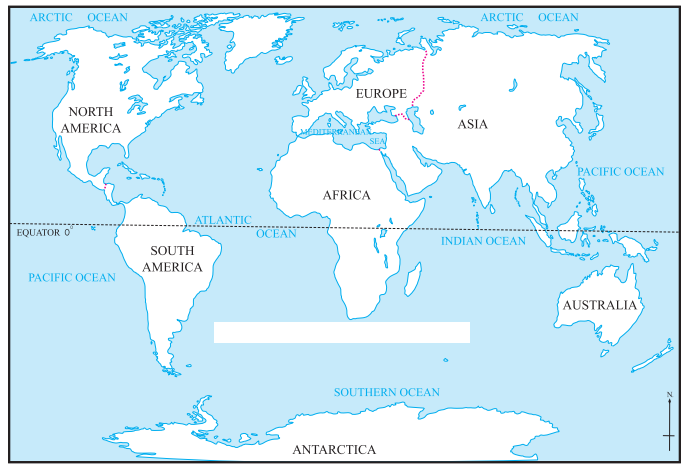
Answer:
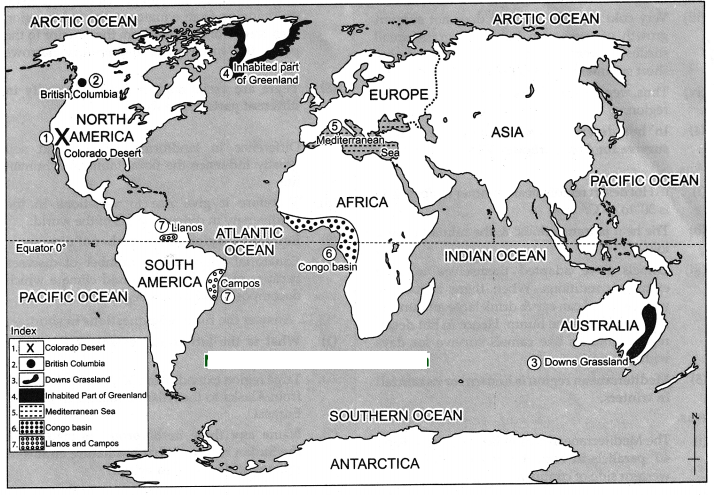
Activity:
Using the Internet, check the information given in this lesson. Collect pictures of the flora and fauna and the human life of the various natural regions. Make a collage by pasting these pictures on the world map.
Class 7 Geography Chapter 6 Natural Regions InText Questions and Answers
Can you tell:
Observe the picture given on Pg. no. 30 of Geography textbook and answer the following question given below.
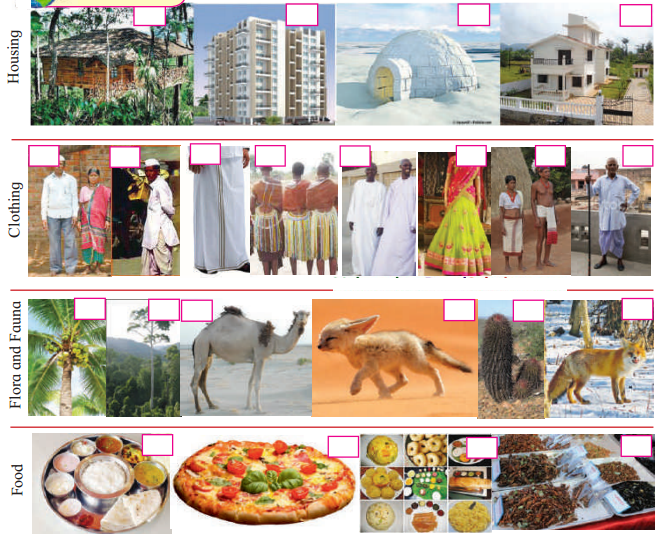

Page no: 31
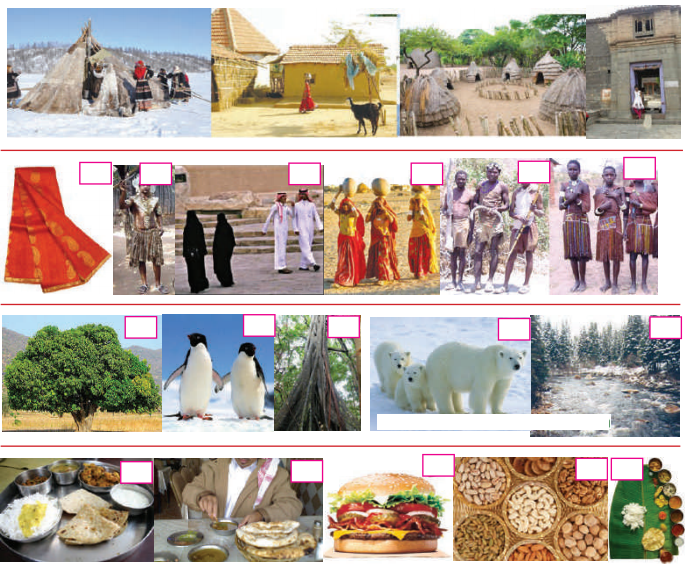
Question 1.
Why are the house types shown in the pictures not seen in our surrounding?
Answer:
All the house types shown in the pictures are not seen in our surroundings because house types differ from place to place. They are built taking into consideration rainfall, temperature and raw material available for building houses.
Question 2.
Which are the regions where such types of houses are found?
Answer:
In cities, we find buildings and bungalows built of concrete material. An igloo is found in the Tundra or Taiga region. Huts are found in grassland or forested areas.
Question 3.
Would you like to stay in a house built of ice? Why don’t we build such houses?
Answer:
Yes, I would like to stay in an ice house. We can’t build it here because the temperature is high which will melt the ice and we don’t have snowfall in Maharashtra.
Question 4.
What brings about difference in people’s clothing?
Answer:
There is difference in people’s clothing because firstly it depends upon the climate of the place. Secondly it depends upon the culture & tradition as well as the raw material available or textile industries that are set up a particular region.
Question 5.
Where do you think Khubz, insects and ants also form a part of the diet of the people?
Answer:
Human beings eat whatever is edible & does not harm their digestive system.
Previously Khubz, insects & ants were consumed mainly by tribal people or people living in underdeveloped countries, but today it is consumed by people for protein, or for tradition or even as exploratory cuisine.
Question 6.
Can the animals from polar region like polar bears and penguins be kept in the tropical zoos?
Answer:
No, polar bear and penguins survive only in colder regions. They cannot bear the tropical heat and may die. Therefore, they are not kept in tropical zoos.

Question 7.
Are all the plants shown in the pictures found in our surroundings? If not, where do you think they can be found?
Answer:
TB pg 30 – The tree shown in 1 st picture is found in the coastal area. The tree in the 2nd picture is found in the equatorial region. The plant in the 3rd picture is found in the hot desert region.
TB pg 31 – The tree in the 1st picture is found in grassland regions.
The tree in 2nd picture is found in the monsoon region
The tree in the 3rd picture is found in the Taiga region.
Think about it:
Question 1.
Why are animals like lions not found in Equatorial forests?
Answer:
(i) Equatorial regions have hot & humid climate & it rains throughout the year. So, dense multilayered evergreen forests are found here.
(ii) As the sunlight does not reach the ground the trees compete to get sunlight & hence trees grow very tall.
(iii) Mainly animals which can survive in swampy & marshy environment of forests are arboreal animals found in equatorial forests.
Hence animals like lions are not found in equatorial forests.
Question 2.
Why are the hot deserts mainly located along the western side of the continents?
Answer:
The planetary winds shed their moisture in the eastern parts of the continents and become dry by the time they reach the western margins. Therefore, hot deserts are mainly located along the western side of the continents.
Question 3.
Why are people in the hot deserts engaged mostly in animal rearing?
Answer:
Hot deserts have very scanty rains and high temperature which does not favour agriculture, therefore people in the hot deserts are mostly engaged in animal rearing.
Question 4.
Why do people in hot deserts live a nomadic life?
Answer:
People in hot deserts rear animals for a living. Therefore they move from place to place in search of water and fodder for their animals.
Question 5.
Why are carnivorous animals found in the grasslands?
Answer:
In the grassland region there are a large number of herbivorous animals. Therefore carnivorous animals are found in large numbers.
Make friends with maps!
Observe the map and answer the following questions
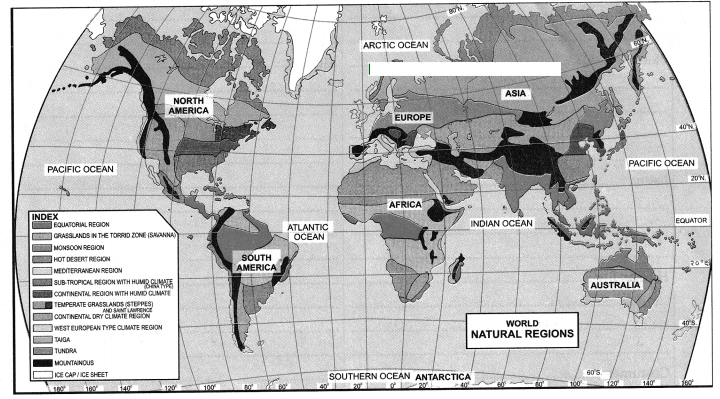
Question 1.
Which natural regions are found in India?
Answer:
Monsoon region is the natural region found in India.
Question 2.
Which continent comprises a major portion of the hot desert type of region?
Answer:
Continent of Africa comprises a major portion of hot desert type region.

Question 3.
Which continent has the highest diversity in terms of natural regions?
Answer:
Continent of Asia has the highest diversity in terms of natural region.
Question 4.
Why are there fewer natural regions in the southern hemisphere than those in the northern hemisphere?
Answer:
Because the land in the southern hemisphere is less and have only in two temperature zones.
Question 5.
Which natural region occupies the largest area in the world.
Answer:
Taiga region occupies the largest area in the world.
Question 6.
Where else do we find conditions similar to the continent of Antarctica?
Answer:
Greenland has conditions similar to continent of Antarctica.
Question 7.
Throughout which natural regions does the Prime Meridian pass?
Answer:
The Prime Meridian passes through Hot deserts, Mediterranean type of climate, Taiga, West European type region.
Observe the table of natural region on Pg. 33 of textbook, then answer the following questions:
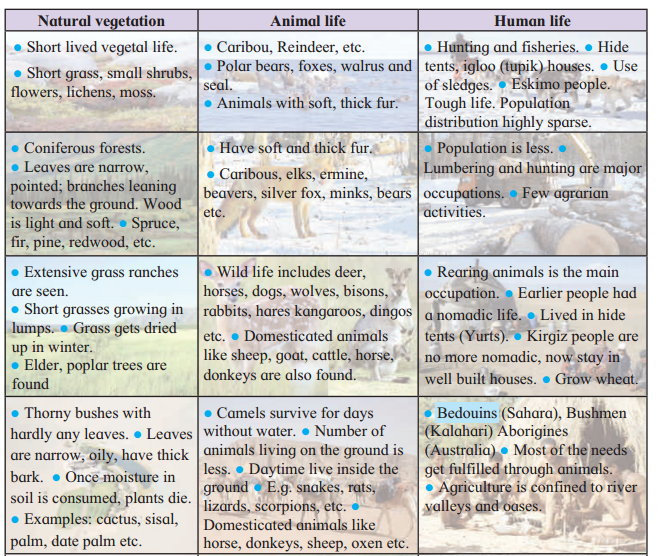
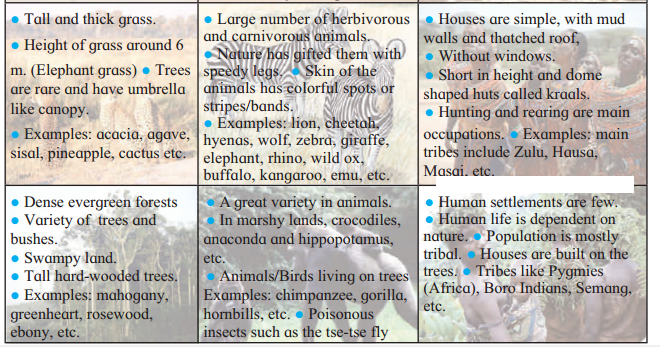
Question 1.
Which natural region consists of short-lived vegetation?
Answer:
Tundra region consists of short-lived vegetation.
Question 2.
In which natural region will you find the kraals?
Answer:
We will find the kraals in Sudan type grassland region.

Question 3.
Which region has winter rains?
Answer:
The Mediterranean region has winter rains.
Question 4.
In which natural regions are gorillas and chimpanzees found?
Answer:
Gorillas and Chimpanzees are found in the Equatorial region.
Question 5.
In which natural region is the land surface in the forests devoid of vegetation?
Answer:
Hot deserts region is devoid of vegetation.
Question 6. Which regions favour dairy farming?
Answer:
Grassland (Prairie and Steppes) favour dairy farming.
Question 7.
Which region is favourable for fruit production?
Answer:
Mediterranean region is favourable for fruit production.
Class 7 Geography Chapter 6 Natural Regions Additional Important Questions and Answers
Fill in the blanks choosing the correct option from the bracket:
Question 1.
The ______ people live in the Steppes grassland and they live a nomadic life. (Zulu, Pygmies, Kirgiz)
Answer:
Zulu
Question 2.
Monsoon region gets rains from the ____ winds. (NE monsoon, SW monsoon, SE monsoon)
Answer:
SW monsoon
Question 3.
_____ cause cyclonic rain in the West European region. (Westerlies, Easterlies, Polar)
Answer:
Westerlies
Question 4.
Sailors and explorers are mainly found in the ______ region. (Mediterranean, Monsoon, West European)
Answer:
Mediterranean

Question 5.
The _______ type of forest is found in the Equatorial region.(Coniferous, Evergreen, Deciduous)
Answer:
Evergreen
Question 6.
The ________ region receives rainfall in winter. (Mediterranean, Equatorial, Taiga)
Answer:
Mediterranean
Question 7.
Seat of Greek and Roman civilization is found in the ______ region. (Taiga, Hot desert, Mediterranean)
Answer:
Mediterranean
Question 8.
In Monsoon region, ______ is the main occupation of the people. (agriculture, animal husbandary, secondary)
Answer:
agriculture
Match the pair correctly:
Question 1.
Answer:
1 – e
2 – d
3 – c
4 – b
5 – a
Do the following tasks:
Question 1.
Write the important occupation of the region in the following table:
Answer:

Question 2.
Find the location of the following regions from the world map and write down in the table given below:
Answer:
Who am I. (Type of region):
Question 1.
I am found in Indonesia and Guinea
Answer:
Equatorial Region

Question 2.
I am found as Llanos and Campos
Answer:
Grasslands (Sudan type)
Question 3.
I am found in the Colorado and the Atacama
Answer:
Hot Desert region
Question 4.
I am found in South America and North America
Answer:
Grassland (steppes and prairies)
Question 5.
I am found from the Alaska to the Atlantic coast
Answer:
Taiga region
Question 6.
I am found in Greenland and North Canada
Answer:
Tundra region
Question 7.
I am found in California.
Answer:
Mediterranean region.
Name the following:
Question 1.
Any two animals of Tundra region
Answer: Reindeer, Polar bears.
Question 2.
Any 2 types of trees of the Taiga region.
Answer:
Spruce, Pine.
Question 3.
A tribe found in the Steppes and Prairies grassland who are no more nomadic.
Answer:
Kirghiz
Question 4.
Any two tribes found in Sudan type grassland region.
Answer:
Zulu, Hausa
Question 5.
Any three hot deserts
Answer:
Sahara (N. Africa), Thar (Asia), Colorado (N. America)
Answer in one sentence:
Question 1.
What is the mean winter temperature in the Tundra region?
Answer:
The mean winter temperature in the tundra region is approximately -20° to -30°C.
Question 2.
How are the summers and winters in Sudan region?
Answer:
In the Sudan region, summers are hot and humid where as winters are warm and dry.
Question 3.
What are the annual rainfall in the Equatorial region?
Answer:
The annual rainfall in the equatorial region is between 2500 and 3000 mm.
Question 4.
Which animal is commonly found in the hot deserts? Why?
Answer:
Camels are commonly found in the hot deserts. as they can survive for days without water.

Question 5.
What are the characteristics of plants in the hot desert region?
Answer:
Their vegetation is in the form of thorny bushes with hardly any leaves; also the leaves are narrow, oily & the plants have a thick bark.
Question 6.
What type of forest are found in the Taiga region?
Answer:
Mainly coniferous forests are found in the Taiga region.
Give Geographical reasons for:
Question 1.
In hot desert region, animals like camels survive for days without water.
Answer:
(i) In Hot desert region mean summer temperature is 30° to 45°C.
(ii) The heat is tremendous & the rainfall is very low.
(iii) Camels have adapted themselves to such extreme conditions. When there is food & water a camel can eat & drink large amounts & store it as fat in the hump. Hence in hot desert region, animals like camels survive for days without water.
Question 2.
The Mediterranean region is known for its rainfall in winters.
Answer:
(i) The Mediterranean region lies between 30°and 40° parallels in both the hemispheres on the western side of continents.
(ii) Therefore, the Mediterranean region comes under the influence of westerlies.
(iii) Hence, it receives rainfall in winter.
Question 3.
Taiga region, lumbering is the main occupation.
Answer:
(i) The Taiga region has a cool climate. The summer temperature ranges between 15° to 20°C & the winter temperature falls below 0°C.
(ii) Hence, mainly coniferous forests are found here.
(iii) The wood of the trees here is light & soft.
(iv) Hence, lumbering is the main occupation in the Taiga region.
Question 4.
As one travels from the equator to the poles the spectrum of biodiversity narrows down.
Answer:
(i) In Equatorial region the occupation is based on forest produce, for eg. gathering of gum, rubber, etc.
(ii) Whereas towards the poles, the availability of natural resources adversely affects the human occupations.
(iii) The availability of sunlight and water keep on changing from equator to the polar region therefore as one travels from the equator to the poles, the spectrum of biodiversity narrows down.
Question 5.
There are variations in the biodiversity in different parts of the world.
Answer:
(i) Difference in landforms, climate and soil greatly influence the flora, fauna and human life.
(ii) Therefore it give rise to variations in the biodiversity in different parts of the world.
Question 6.
Equatorial region has a number of diseases.
Answer:
Equatorial region has a number of diseases because of the hot and humid climate which ,decomposes and causes vegetal litter.

Answer the following questions in short:
Question 1.
Describe coniferous trees in the Taiga region.
Answer:
Question 2.
Describe the vegetation in the Mediterranean region.
Answer:
Question 3.
What types of forests are found in the Monsoon region?
Answer:
In the Monsoon region, semi-evergreen and deciduous forest are found.
Answer the following questions in detail:
Question 1.
What are the characteristics of the West European Region?
Answer:
The characteristics of the West European Region are as follows
Question 2.
What are the characteristics of the Mediterranean region?
Answer:
The characteristics of the Mediterranean region are as follows :
Arrange the name of the region given in the semicircular globe depending on the parallels they lie:
Question 1.
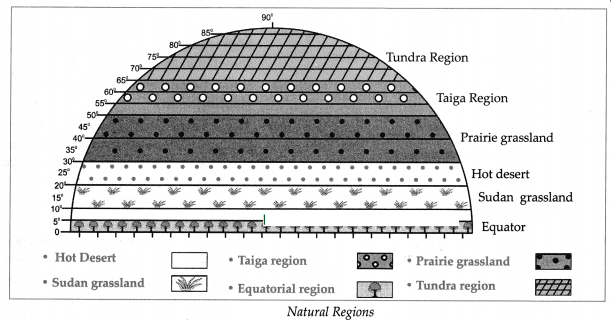
Answer:
Chapter 6 Natural Regions Notes, Textbook Exercise Important Questions and Answers.
Class 7 Geography Chapter 6 Natural Regions Textbook Questions and Answers
1. Read the following statements carefully. Correct the wrong ones and write them down:
Natural Regions Class 7 Geography Question 1.
Due to its mild and warm climate, people from the West European region are not energetic.
Answer:
False – Due to its mild and warm climate people from the West European region are industrious and energetic.
Std 7 Geography Chapter 6 Natural Regions Question 2.
The prairie region is called the wheat basket of the world.
Answer:
True.

Natural Regions Class 7 Questions And Answers Question 3.
The trees in the Mediterranean region have oily leaves and the bark is quite thick. There is a high rate of transpiration.
Answer:
False – The trees in the hot desert region have oily leaves and the bark is quite thick. There is high rate of transpiration.
Natural Regions Class 7 Question 4.
The camel is an important animal of the hot desert region as it can survive without water and is useful for transport.
Answer:
True.
Class 7 Geography Chapter 6 Natural Regions Question 5.
Carnivorous animals like tigers and lions are found in large numbers in the equatorial regions.
Answer:
False – Carnivorous animals like tigers and lions are found in large numbers in the grassland region (Sudan).
2. Give geographical reasons:
6 Natural Regions Question 1.
People in monsoon region are mainly engaged in agriculture.
Answer:
(i) The monsoon region is located in tropical & subtropical belt between 10° & 30°N & parallels which receives almost perpendicular rays of the sun for most part of the year.
(ii) The summers temperature are hot with between 27° & 32°C & the winters are mild with temperatures between 15° to 24°C.
(iii) This region receives rainfall during specific season from the south west monsoon winds and the rainfall varies between 250 to 2500 mm.
(iv) Thus as the climatic conditions are such that they favour growth of variety of crops.
(v) Thus, people in the monsoon region are engaged in agriculture.
Natural Regions Std 7 Question 2.
Trees in equatorial forests grow tall.
Answer:
(i) The equatorial forest are found in regions between 50°N & 50°S of the equator. This region receives perpendicular rays of the sun throughout the year.
(ii) The climate of the equatorial region is hot & it receives rainfall throughout the year. Annual rainfall in this region is between 2500 & 3000 mm.
(iii) Hence, dense evergreen forests are found here. Due to dense vegetation sunlight does not reach the ground & the trees compete for sunlight.
(iv) Thus, trees in equatorial forests grow tall.

Question 3.
Vegetation is short-lived in the Tundra region.
Answer:
(i) Tundra region is located between 65°N to 90°N parallels due to which the climate here is very cold.
(ii) The mean summer temperatures is between 20°C to 30°C.
(iii) Very cold climate of winter does not support growth of vegetation but short grass, small shrubs, flowers, lichen, moss etc. grow during short summer period here
(iv) Thus, vegetation is short-lived in the Tundra region.
3. Answer the following questions:
Question 1.
What is the latitudinal extent of the Taiga . region?
Answer:
Taiga region extends from 55° to 65° N latitudes from Alaska to the Atlantic coast & in parts of Eurasia.
Question 2.
Name any three herbivorous animals from the Sudan region. What has nature endowed them with for self-protection?
Answer:
Question 3.
What are the characteristics of the Monsoon region?
Answer:
The characteristics of the Monsoon region are as follows:
4. Show the following items on an outline map of the world. Prepare the index:

Answer:

Activity:
Using the Internet, check the information given in this lesson. Collect pictures of the flora and fauna and the human life of the various natural regions. Make a collage by pasting these pictures on the world map.
Class 7 Geography Chapter 6 Natural Regions InText Questions and Answers
Can you tell:
Observe the picture given on Pg. no. 30 of Geography textbook and answer the following question given below.


Page no: 31

Question 1.
Why are the house types shown in the pictures not seen in our surrounding?
Answer:
All the house types shown in the pictures are not seen in our surroundings because house types differ from place to place. They are built taking into consideration rainfall, temperature and raw material available for building houses.
Question 2.
Which are the regions where such types of houses are found?
Answer:
In cities, we find buildings and bungalows built of concrete material. An igloo is found in the Tundra or Taiga region. Huts are found in grassland or forested areas.
Question 3.
Would you like to stay in a house built of ice? Why don’t we build such houses?
Answer:
Yes, I would like to stay in an ice house. We can’t build it here because the temperature is high which will melt the ice and we don’t have snowfall in Maharashtra.
Question 4.
What brings about difference in people’s clothing?
Answer:
There is difference in people’s clothing because firstly it depends upon the climate of the place. Secondly it depends upon the culture & tradition as well as the raw material available or textile industries that are set up a particular region.
Question 5.
Where do you think Khubz, insects and ants also form a part of the diet of the people?
Answer:
Human beings eat whatever is edible & does not harm their digestive system.
Previously Khubz, insects & ants were consumed mainly by tribal people or people living in underdeveloped countries, but today it is consumed by people for protein, or for tradition or even as exploratory cuisine.
Question 6.
Can the animals from polar region like polar bears and penguins be kept in the tropical zoos?
Answer:
No, polar bear and penguins survive only in colder regions. They cannot bear the tropical heat and may die. Therefore, they are not kept in tropical zoos.

Question 7.
Are all the plants shown in the pictures found in our surroundings? If not, where do you think they can be found?
Answer:
TB pg 30 – The tree shown in 1 st picture is found in the coastal area. The tree in the 2nd picture is found in the equatorial region. The plant in the 3rd picture is found in the hot desert region.
TB pg 31 – The tree in the 1st picture is found in grassland regions.
The tree in 2nd picture is found in the monsoon region
The tree in the 3rd picture is found in the Taiga region.
Think about it:
Question 1.
Why are animals like lions not found in Equatorial forests?
Answer:
(i) Equatorial regions have hot & humid climate & it rains throughout the year. So, dense multilayered evergreen forests are found here.
(ii) As the sunlight does not reach the ground the trees compete to get sunlight & hence trees grow very tall.
(iii) Mainly animals which can survive in swampy & marshy environment of forests are arboreal animals found in equatorial forests.
Hence animals like lions are not found in equatorial forests.
Question 2.
Why are the hot deserts mainly located along the western side of the continents?
Answer:
The planetary winds shed their moisture in the eastern parts of the continents and become dry by the time they reach the western margins. Therefore, hot deserts are mainly located along the western side of the continents.
Question 3.
Why are people in the hot deserts engaged mostly in animal rearing?
Answer:
Hot deserts have very scanty rains and high temperature which does not favour agriculture, therefore people in the hot deserts are mostly engaged in animal rearing.
Question 4.
Why do people in hot deserts live a nomadic life?
Answer:
People in hot deserts rear animals for a living. Therefore they move from place to place in search of water and fodder for their animals.
Question 5.
Why are carnivorous animals found in the grasslands?
Answer:
In the grassland region there are a large number of herbivorous animals. Therefore carnivorous animals are found in large numbers.
Make friends with maps!
Observe the map and answer the following questions

Question 1.
Which natural regions are found in India?
Answer:
Monsoon region is the natural region found in India.
Question 2.
Which continent comprises a major portion of the hot desert type of region?
Answer:
Continent of Africa comprises a major portion of hot desert type region.

Question 3.
Which continent has the highest diversity in terms of natural regions?
Answer:
Continent of Asia has the highest diversity in terms of natural region.
Question 4.
Why are there fewer natural regions in the southern hemisphere than those in the northern hemisphere?
Answer:
Because the land in the southern hemisphere is less and have only in two temperature zones.
Question 5.
Which natural region occupies the largest area in the world.
Answer:
Taiga region occupies the largest area in the world.
Question 6.
Where else do we find conditions similar to the continent of Antarctica?
Answer:
Greenland has conditions similar to continent of Antarctica.
Question 7.
Throughout which natural regions does the Prime Meridian pass?
Answer:
The Prime Meridian passes through Hot deserts, Mediterranean type of climate, Taiga, West European type region.
Observe the table of natural region on Pg. 33 of textbook, then answer the following questions:


Question 1.
Which natural region consists of short-lived vegetation?
Answer:
Tundra region consists of short-lived vegetation.
Question 2.
In which natural region will you find the kraals?
Answer:
We will find the kraals in Sudan type grassland region.

Question 3.
Which region has winter rains?
Answer:
The Mediterranean region has winter rains.
Question 4.
In which natural regions are gorillas and chimpanzees found?
Answer:
Gorillas and Chimpanzees are found in the Equatorial region.
Question 5.
In which natural region is the land surface in the forests devoid of vegetation?
Answer:
Hot deserts region is devoid of vegetation.
Question 6. Which regions favour dairy farming?
Answer:
Grassland (Prairie and Steppes) favour dairy farming.
Question 7.
Which region is favourable for fruit production?
Answer:
Mediterranean region is favourable for fruit production.
Class 7 Geography Chapter 6 Natural Regions Additional Important Questions and Answers
Fill in the blanks choosing the correct option from the bracket:
Question 1.
The ______ people live in the Steppes grassland and they live a nomadic life. (Zulu, Pygmies, Kirgiz)
Answer:
Zulu
Question 2.
Monsoon region gets rains from the ____ winds. (NE monsoon, SW monsoon, SE monsoon)
Answer:
SW monsoon
Question 3.
_____ cause cyclonic rain in the West European region. (Westerlies, Easterlies, Polar)
Answer:
Westerlies
Question 4.
Sailors and explorers are mainly found in the ______ region. (Mediterranean, Monsoon, West European)
Answer:
Mediterranean

Question 5.
The _______ type of forest is found in the Equatorial region.(Coniferous, Evergreen, Deciduous)
Answer:
Evergreen
Question 6.
The ________ region receives rainfall in winter. (Mediterranean, Equatorial, Taiga)
Answer:
Mediterranean
Question 7.
Seat of Greek and Roman civilization is found in the ______ region. (Taiga, Hot desert, Mediterranean)
Answer:
Mediterranean
Question 8.
In Monsoon region, ______ is the main occupation of the people. (agriculture, animal husbandary, secondary)
Answer:
agriculture
Match the pair correctly:
Question 1.
| Region | Latitudinal extent |
| (1) Tundra region | (a) 5° to 20° N and S |
| (2) Taiga region | (b) 20° to 30° N and S |
| (3) Grassland (Steppes and Prairies | (c) 30° to 55° N and S |
| (4) Hot Desert | (d) 55° to 65° N and S |
| (5) Grassland (Sudan type) | (e) 65° to 90° N and S |
1 – e
2 – d
3 – c
4 – b
5 – a
Do the following tasks:
Question 1.
Write the important occupation of the region in the following table:
Answer:

Question 2.
Find the location of the following regions from the world map and write down in the table given below:
Answer:
| Regions | Location |
| (1) Tundra region | (a) Greenland, N. Canada, N. Europe, North Asia. |
| (2) Taiga region | (b) Alaska to the Atlantic coast, Parts of Eurasia. |
| (3) Grasslands (Steppes and Prairies) | (c) Steppes (Eurasia), Velds (South Africa), Pampas (S. America), Prairies (N. America), Down (Australia), etc. |
| (4) Hot Desert region | (d) In the western parts of continents, Sahara (N. Africa), Colorado (N.America), Atacama (S.America), Kalahari (S. Africa), Thar (Asia), etc. |
| (5) Grasslands (Sudan type) | (e) Savanna (Africa), Queensland (Australia), the Parkland (Africa), Llanos and Campos (S.America) and other grasslands. |
| (6) Equatorial region | (f) Malaysia, Indonesia, Singapore, Guinea, Cango basin, Amazon basin. |
| (7) Monsoon region | (g) Indian subcontinent, Philippines, West Indies, N. Australia, E. Africa, E. America etc. |
| (8) Mediterranean region | (h) Portugal, Spain, Algeria, Turkey, California, Central Chile, SW and NE Australia, etc. |
| (9) West European region | (i) Norway, Denmark, Ireland, British Colombia, South Chile, New Zealand, etc. |
Question 1.
I am found in Indonesia and Guinea
Answer:
Equatorial Region

Question 2.
I am found as Llanos and Campos
Answer:
Grasslands (Sudan type)
Question 3.
I am found in the Colorado and the Atacama
Answer:
Hot Desert region
Question 4.
I am found in South America and North America
Answer:
Grassland (steppes and prairies)
Question 5.
I am found from the Alaska to the Atlantic coast
Answer:
Taiga region
Question 6.
I am found in Greenland and North Canada
Answer:
Tundra region
Question 7.
I am found in California.
Answer:
Mediterranean region.
Name the following:
Question 1.
Any two animals of Tundra region
Answer: Reindeer, Polar bears.
Question 2.
Any 2 types of trees of the Taiga region.
Answer:
Spruce, Pine.
Question 3.
A tribe found in the Steppes and Prairies grassland who are no more nomadic.
Answer:
Kirghiz
Question 4.
Any two tribes found in Sudan type grassland region.
Answer:
Zulu, Hausa
Question 5.
Any three hot deserts
Answer:
Sahara (N. Africa), Thar (Asia), Colorado (N. America)
Answer in one sentence:
Question 1.
What is the mean winter temperature in the Tundra region?
Answer:
The mean winter temperature in the tundra region is approximately -20° to -30°C.
Question 2.
How are the summers and winters in Sudan region?
Answer:
In the Sudan region, summers are hot and humid where as winters are warm and dry.
Question 3.
What are the annual rainfall in the Equatorial region?
Answer:
The annual rainfall in the equatorial region is between 2500 and 3000 mm.
Question 4.
Which animal is commonly found in the hot deserts? Why?
Answer:
Camels are commonly found in the hot deserts. as they can survive for days without water.

Question 5.
What are the characteristics of plants in the hot desert region?
Answer:
Their vegetation is in the form of thorny bushes with hardly any leaves; also the leaves are narrow, oily & the plants have a thick bark.
Question 6.
What type of forest are found in the Taiga region?
Answer:
Mainly coniferous forests are found in the Taiga region.
Give Geographical reasons for:
Question 1.
In hot desert region, animals like camels survive for days without water.
Answer:
(i) In Hot desert region mean summer temperature is 30° to 45°C.
(ii) The heat is tremendous & the rainfall is very low.
(iii) Camels have adapted themselves to such extreme conditions. When there is food & water a camel can eat & drink large amounts & store it as fat in the hump. Hence in hot desert region, animals like camels survive for days without water.
Question 2.
The Mediterranean region is known for its rainfall in winters.
Answer:
(i) The Mediterranean region lies between 30°and 40° parallels in both the hemispheres on the western side of continents.
(ii) Therefore, the Mediterranean region comes under the influence of westerlies.
(iii) Hence, it receives rainfall in winter.
Question 3.
Taiga region, lumbering is the main occupation.
Answer:
(i) The Taiga region has a cool climate. The summer temperature ranges between 15° to 20°C & the winter temperature falls below 0°C.
(ii) Hence, mainly coniferous forests are found here.
(iii) The wood of the trees here is light & soft.
(iv) Hence, lumbering is the main occupation in the Taiga region.
Question 4.
As one travels from the equator to the poles the spectrum of biodiversity narrows down.
Answer:
(i) In Equatorial region the occupation is based on forest produce, for eg. gathering of gum, rubber, etc.
(ii) Whereas towards the poles, the availability of natural resources adversely affects the human occupations.
(iii) The availability of sunlight and water keep on changing from equator to the polar region therefore as one travels from the equator to the poles, the spectrum of biodiversity narrows down.
Question 5.
There are variations in the biodiversity in different parts of the world.
Answer:
(i) Difference in landforms, climate and soil greatly influence the flora, fauna and human life.
(ii) Therefore it give rise to variations in the biodiversity in different parts of the world.
Question 6.
Equatorial region has a number of diseases.
Answer:
Equatorial region has a number of diseases because of the hot and humid climate which ,decomposes and causes vegetal litter.

Answer the following questions in short:
Question 1.
Describe coniferous trees in the Taiga region.
Answer:
Question 2.
Describe the vegetation in the Mediterranean region.
Answer:
Question 3.
What types of forests are found in the Monsoon region?
Answer:
In the Monsoon region, semi-evergreen and deciduous forest are found.
Answer the following questions in detail:
Question 1.
What are the characteristics of the West European Region?
Answer:
The characteristics of the West European Region are as follows
Question 2.
What are the characteristics of the Mediterranean region?
Answer:
The characteristics of the Mediterranean region are as follows :
Arrange the name of the region given in the semicircular globe depending on the parallels they lie:
Question 1.

Answer: